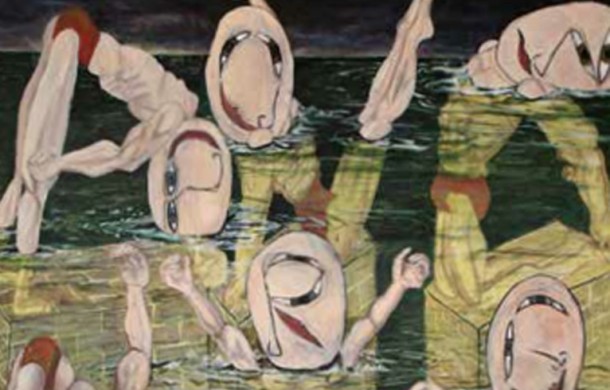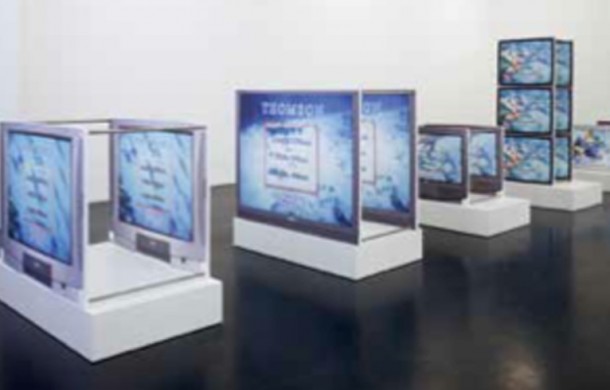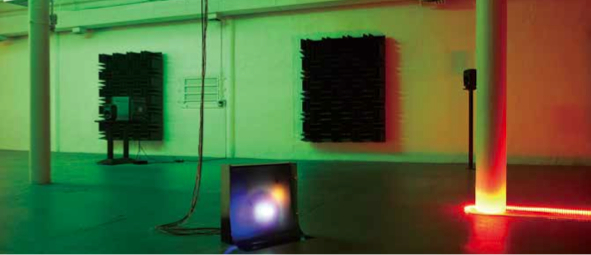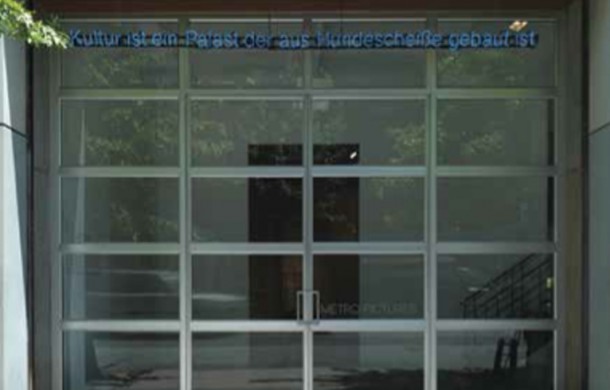MOVING UP
| May 10, 2013 | Post In LEAP 18

JANA EULER
Although the Brussels-based German artist Jana Euler could be said to take inspiration from social networks— her practice suggests a cyber-punk aesthetic— she actually works through the decidedly historical genre of painting of Neue Sachlichkeit (New Objectivity). A series of paintings completed largely in 2009, the year after she completed graduate school, takes mostly male authority figures within her social network as subject matter. Euler renders her school’s rector, Daniel Birbaum, his arms open and hands holding what appears to be an invisible orb in the pallid realism of Neue Sachlichkeit. The background, a choppy sea against a night sky depicting the constellation of Cancer, provides an anti-rational juxtaposition with the authority and power that Birbaum, a white male, represents. Euler’s new works recall modernist painters such as Paul Klee and Jean Dubuffet. Her painting Anonymous Powergame depicts nine muscular male figures half-submerged in what appears to be a pool, their faces contorted to spell out successively “POWERGAME.” Euler’s work re-imagines what feminist and institutional critiques could look like in the twenty-first century, uniquely reworking these concerns through the rhetoric of painting.
A current resident at Wiels Contemporary Art Center in Brussels, Euler is a graduate of the Staatliche Hochschule für Bildende Künste, Frankfurt am Main. She is represented by dépendance, Brussels, and has recently mounted exhibitions at Real Fine Arts, Brooklyn; Mathew, Berlin; Portikus, Frankfurt; Air de Paris, Paris; Etablissement d’en face, Brussels; and Pro Choice, Vienna.

Courtesy of Galerie Buchholz, Cologne/ Berlin
SIMON DENNY
Berlin-based artist Simon Denny’s work often contemplates the increasing presence and sophistication of technology within our daily lives. His oeuvre borrows technological artifacts— such as chunky television casings or vintage industry magazines such as Corporate Video Decisions— and steeps them in the rhetoric of both museological display and art history. Denny’s work asks how the experience of an object can be mediated by contextual clues, manipulable by an artist. In his own words: “… determin[ing] how much information one has access to around an object and how one receives this info is really engaging for me. It can be even more challenging to play with these dynamics around objects we are used to living closely with, because we think we know what they’re about.” In the winter of 2013, Denny will launch a project with Kunstverein Munich in which he presents the history of the previous year’s DLD conference in a chronological, step-by-step fashion with the branding and visual identity associated with that year. As DLD (itself an acronym for “digital—life— design”) is a conference that serves to proffer the newest of the new in the tech and design industries, highlighting the event’s happenings of last year questions what newness looks like, how we aestheticize it, and what the functionality of recently-not-new information is today.
A graduate of Staatliche Hochschule für Bildende Künste, Frankfurt am Main, Denny is represented by Michael Lett, Auckland; Friedrich Petzel, New York; T293 Naples and Rome; and Galerie Buchholz, Berlin and Cologne. In 2012, he won both Art Basel’s Bâloise Art Prize as well as the Ars Viva Prize. In addition to his project at Kunstverein Munich, Denny will present a solo exhibition at Friedrich Petzel in New York in the summer of 2013. He lives and works in Berlin.

CALLA HENKEL AND MAX PITEGOFF
Upon receiving their BFAs from Manhattan’s Cooper Union, Calla Henkel and Max Pitegoff moved to Berlin to foster their artistic practice unfettered by the financial constraints of living and working in New York. Along with Berlin-based American artist Lindsay Lawson, Henkel and Pitegoff started the short-lived Berlin-based bar and event space, Times. Running from July 2011 through September 2012, the Neükolln-based drinking hole brought together a tight-knit community of expat artists, many on the brink of international success (including Simon Denny; see below), the work of whom was often hung behind the establishment’s bar. While Henkel and Pitegoff see Times as a distant extension of their artistic practice, having earlier initiated a bar during their days at Cooper Union, the duo’s work centers around a meta-level investigation of the performance of the young artist, often using Times as a source for material. Their spring 2012 exhibition at T293, Naples, exemplified just that. Titled “Notes on American Performance,” the exhibition comprised tiled structures resembling the bar at Times, self-portraits and large-scale photographs of loved ones, oversized aluminum “newspapers” screen-printed with texts on performance written by peers, as well as glasses filled with tinted resin appearing like cocktails. Similarly, their late autumn exhibition at Tomorrow Gallery in Toronto featured photographs and a sculptural string of lights and Times resin cocktail glasses memorializing their bar as well as other artist-run spaces in Berlin. Such a venture speaks to the keenly felt, almost anxious impermanence of both youth and non-commercial spaces maintaining both vim and an operating budget simultaneously.
Henkel and Pitegoff open “Black Cake,” a group exhibition curated by Interview and Art in America online editor Alex Gartenfeld at Team Gallery, New York in January 2013. They will open a project at New Theater in Berlin in March, and mount a solo exhibition at VI, VII in Oslo in the spring of 2013.

PHOTO: Jesse Untracht-Oakner
HAROON MIRZA
Due to its aesthetic idiosyncrasy and weirdly synesthetic, concertedly phenomenological presence, Haroon Mirza’s work is exceedingly difficult to describe. The winner of the 2011 Venice Biennale’s Silver Lion (a prestigious award given to one promising young artist shown in the Venice Biennale), Mirza creates immersive installations comprising architectural interventions and audiovisual technologies both scavenged and new complemented by soundtracks of bleeps and blips. His solo exhibition at Studio 231, a new annex of the New Museum, is his first in New York. Titled “Preoccupied Waveforms,” the exhibition carefully places LED lights, soundproofing foam spikes, a vintage monitor, and other technological components throughout the gallery. Walking into the space, which is considerably raw in comparison to the pristine boxiness of the New Museum, feels akin to stumbling into a tech nerd’s dungeon. A motherboard connects a vintage monitor, strings of lights, and a booming mechanical soundtrack so that the constituent parts of the installation act as a whole, reacting to each other in a manner perhaps better suited to an alien planet’s Christmas light show (provided Christmas is observed there).
Mirza is a graduate of Goldsmiths College and Chelsea College of Art and Design. He has recently mounted exhibitions at Chisenhale Gallery, London, the Camden Arts Centre, London, and Spike Island, Bristol. In addition to the 54th Venice Biennale, his work has been included in a number of international surveys, including the British Art Show 7 (2010) and Performa 11. Mirza, who is represented by Lisson Gallery in London, lives and works in London and Sheffield, United Kingdom.

CLAIRE FONTAINE
The unwaveringly left-leaning Paris-based duo Claire Fontaine was founded in 2004, a time when Western economies were curiously bloated. Taking their name from a popular brand of school supplies in France, Claire Fontaine speaks from the subjectivity of a singular female in the third person, although they operate as a collective.
Claire Fontaine’s work is often text-based in nature, pulling quotes from and skewing references to historical and critical texts by authors such as Agamben and Benjamin, while sometimes penning essays themselves. Their visual work employs production conventions within art history to question the slippery status of art as a luxury good. Take their piece, “ARBEIT MACHT KAPITAL,” (2005/2012) which renders these words in neon. An obvious reference to Auschwitz concentration camp’s gates, the sign crowning it reading the German words “ARBEIT MACHT FREI,” or in English, “Work makes you free,” “ARBEIT MACHT KAPITAL,” could be translated as “Work makes you money.” This piece compares the delusion of a popularly-held maxim about capitalism— that if you work, you will make a good living— to the false promises of the Auschwitz gates, whose prisoners were told that if they worked diligently, they would be set free rather than killed.
Claire Fontaine is represented by Metro Pictures and Reena Spaulings Fine Art, New York; and T293 Naples and Rome. The collective was recently featured in the 9th Shanghai Biennale and the group exhibitions “Realness Respect” at Kunstverein Medienturn, Graz; “Doppelgänger—Les Séparés” at CEAAC European Centre for Contemporary Art Projects, Strasbourg; and “Carelessness Causes Fire,” Audain Gallery at Simon Fraser University, Vancouver.


